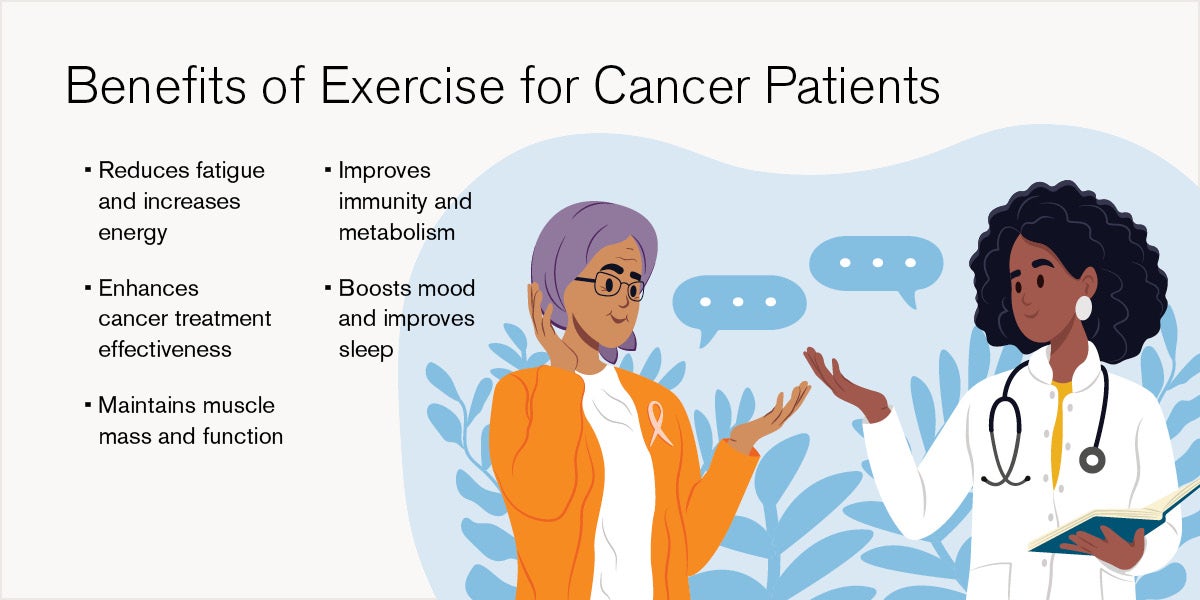How exercise supports cancer treatment and recovery
September 29, 2025
When facing a cancer diagnosis, patients often find themselves navigating a mix of emotions, medical decisions and physical challenges. Amidst these difficulties, exercise can be a powerful tool during cancer treatment and is increasingly recognized for its ability to support healing and improve outcomes. A growing body of research confirms that exercise during and after cancer treatment is not only safe, but it can be profoundly beneficial.
“For years, we’ve known that exercise reduces the risk of cancer. But what’s truly exciting is the emerging evidence showing that exercise can enhance cancer treatment itself," says Eugene Ahn, MD, an oncologist at Loyola Medicine.
Why exercise matters during cancer treatment
Cancer therapies such as chemotherapy, radiation and surgery can take a significant toll on the body. Fatigue, muscle loss, anxiety and sleep disturbances are common side effects. Exercise offers a counterbalance to these challenges, helping patients maintain strength, improve mood and enhance overall quality of life.
“We used to tell patients to rest during chemotherapy, to listen to their fatigue and take it easy. But the research now tells us the opposite. Movement, even gentle movement, can reduce side effects, improve energy and improve well-being” says Dr. Ahn.
Exercise during and after cancer treatment supports overall health and recovery in several essential ways:
1. Reducing cancer-related fatigue
Fatigue is a very common symptom for many patients undergoing treatment. A meta-analysis of randomized controlled trials found that aerobic exercise, such as walking or cycling, reduced fatigue by a significant margin. Even light movement, like 10-minute walks, can help restore energy and reduce the need for rest breaks throughout the day.
2. Enhancing treatment efficacy
Preclinical studies show that exercise can enhance the effectiveness of chemotherapy and hormone therapies, with exercise improving drug efficacy. Clinically, patients who exercised before or after their main course of treatment showed improved tumor response and survival outcomes.
3. Preserving muscle mass and physical function
Cancer cachexia, also known as muscle wasting, is a serious concern. Resistance training just twice a week can help maintain lean muscle mass and bone density. This is especially important for older adults, who may lose a certain amount of muscle mass during treatment without intervention.
4. Improving immune and metabolic function
Exercise stimulates immune surveillance and reduces systemic inflammation. It also improves tumor vascularization, which may enhance drug delivery and reduce tumor hypoxia. Biomarkers such as insulin, IGF-1 and C-reactive protein also improve with regular physical activity.
5. Supporting mental health and sleep
Exercise is a proven mood booster. It reduces anxiety and depression by increasing endorphins and regulating cortisol levels. Mind-body exercises like yoga and tai chi have been shown to improve sleep quality and reduce chemotherapy-induced cognitive impairment.

Exercise and cancer survivorship
Beyond the treatment phase, exercise continues to play a critical role in survivorship. Studies of breast, colorectal and prostate cancer survivors show that regular physical activity is associated with a significant reduction in recurrence risk and improved overall survival.
The American Cancer Society recommends:
- 150 to 300 minutes of moderate aerobic activity per week
- Two or more sessions of resistance training weekly
- Stretching exercises at least twice a week
For cancer patients or survivors who have less energy, these guidelines are flexible. Survivors are encouraged to start slowly and build up based on their energy levels and physical limitations.
“We can’t simply prescribe 150 minutes of exercise per week to every patient. Many are older, frail or dealing with complex side effects. That’s why personalized plans and supervised programs are so important,” says Dr. Ahn.
Exercise during cancer treatment is not one-size-fits-all. Factors such as anemia, bone metastases, neuropathy and surgical recovery must be considered. Patients should consult with their care team before starting any program, especially if they have balance issues, fatigue or are at risk for infection.
Certified exercise physiologists or oncology-trained physical therapists can help design safe, effective routines. Even short sessions can yield significant benefits.
Loyola Medicine’s Integrative Breast Oncology Clinic
For patients seeking a holistic, evidence-based approach to breast cancer care, Loyola Medicine’s Integrative Oncology Clinic supports patients physically, emotionally and spiritually throughout their cancer journey. Designed to support patients during the critical weeks after diagnosis, the clinic combines conventional treatment with integrative therapies that promote healing and resilience.
- Personalized exercise and nutrition plans
- Mind-body support for anxiety, fatigue and sleep
- Guidance on supplements and complementary therapies
- Fast access to appointments and telehealth options
Loyola’s team listens deeply, respects each patient’s voice and collaborates to create a care plan that supports body, mind and spirit.
“We’ve partnered with the Gottlieb Center for Fitness to offer a two-month membership for just $99 to newly diagnosed patients. It includes access to classes and personalized coaching from an exercise physiologist. Supervised exercise has been shown to improve outcomes and reduce risks,” says Dr. Ahn.

